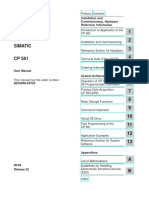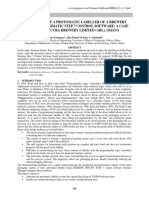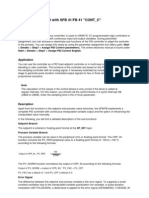PWM HSC S7 1200
PWM HSC S7 1200
Uploaded by
Md. Tauhidul IslamCopyright:
Available Formats
PWM HSC S7 1200
PWM HSC S7 1200
Uploaded by
Md. Tauhidul IslamOriginal Title
Copyright
Available Formats
Share this document
Did you find this document useful?
Is this content inappropriate?
Copyright:
Available Formats
PWM HSC S7 1200
PWM HSC S7 1200
Uploaded by
Md. Tauhidul IslamCopyright:
Available Formats
CTRL_PWM: Pulse-width modulation (S7-1200, S7-1500)
CTRL_PWM: Pulse-width modulation
Description
You can use the "CTRL_PWM" instruction to enable and disable a pulse output supported by the CPU
using the software.
Note
Pulse output parameters are assigned exclusively in the device configuration and not using the
"CTRL_PWM" instruction. Any change of parameters that is intended to have an effect on the CPU
must therefore be made while the CPU is in STOP mode.
You enter the hardware ID of the pulse output you want to control with the instruction in the PWM
input. Error-free execution of the instruction is possible only when the specified pulse output is ena
bled in the hardware configuration.
Only tags of "HW_PWM" data type can be specified in the PWM input. The hardware data type
HW_PWM has a length of one WORD.
The pulse output is enabled when the bit in the ENABLE input of the instruction is set. If ENABLE has
the value TRUE, the pulse output generates pulses that have the properties defined in the device con
figuration. When the bit in the ENABLE input is reset or the CPU changes to STOP, the pulse output
is disabled and no more pulses are generated.
The "CTRL_PWM " instruction is only executed if the signal state in the EN input is "1".
Since the S7-1200 enables the pulse output when the "CTRL_PWM" instruction is executed, BUSY at
S7-1200 always has the value FALSE.
The ENO enable output is set only when the EN enable input has signal state "1" and no errors have
occurred during execution of the instruction.
Note
Use of the force table for PWM and PTO
Digital inputs and outputs that are used for PWM and PTO cannot be forced. Digital inputs and out
puts that were assigned via device configuration cannot be controlled by either the force table or
the monitoring table.
Parameters
The following table shows the parameters of the "CTRL_PWM" instruction:
Parameter
Declaration
Data type
Memory area
Description
PWM
Input
HW_PWM
(WORD)
I, Q, M, L or con
Hardware ID of the pulse generator
stant
ENABLE
Input
BOOL
I, Q, M, D, L or
constant
The pulse output is enabled when
ENABLE = TRUE and disabled when
ENABLE = FALSE.
BUSY
Output
BOOL
I, Q, M, D, L
Processing status
STATUS
Output
WORD
I, Q, M, D, L
Status of the instruction
For additional information on valid data types, refer to "Overview
Overview of the valid data types".
types
-1-
CTRL_PWM: Pulse-width modulation (S7-1200, S7-1500)
Parameter STATUS
Error code*
(W#16#...)
Description
No error
80A1
Hardware ID of the pulse generator is invalid
* The error codes can be displayed as integer or hexadecimal values in the program editor. For ad
ditional information on toggling display formats, refer to "See also".
-2-
CTRL_HSC: Control high-speed counters (S7-1200, S7-1500)
CTRL_HSC: Control high-speed counters
Parameter
Parameter
Data type
Memory area
Description
EN
BOOL
I, Q, M, D, L
Enable input
ENO
BOOL
I, Q, M, D, L
Enable output
HSC
HW_HSC
I, Q, M or constant
Hardware address of
the high-speed counter
(HW-ID)
DIR
BOOL
I, Q, M, D, L or constant
Enables the new count
direction (see
NEW_DIR)
CV
BOOL
I, Q, M, D, L or constant
Enables the new count
value (see NEW_CV)
RV
BOOL
I, Q, M, D, L or constant
Enables the new refer
ence value (see
NEW_RV)
PERIOD
BOOL
I, Q, M, D, L or constant
Enables the new period
of a frequency meas
urement (see
NEW_PERIOD)
NEW_DIR
INT
I, Q, M, D, L or constant
Count direction loaded
when DIR = TRUE.
NEW_CV
DINT
I, Q, M, D, L or constant
Count value loaded
when CV = TRUE.
NEW_RV
DINT
I, Q, M, D, L or constant
Reference value loa
ded when RV = TRUE.
NEW_PERIOD
INT
I, Q, M, D, L or constant
Period of the frequency
measurement loaded
when PERIOD =
TRUE.
BUSY
BOOL
I, Q, M, D, L
Processing status
STATUS
WORD
I, Q, M, D, L
Status of the operation
Description
With the "Control high-speed counters" instruction, you can make parameter settings and control the
high-speed counters supported by the CPU by loading new values into the counter. Execution of the
instruction requires that the high-speed counter to be controlled is enabled. You cannot execute multi
ple "Control high-speed counters" instructions simultaneously in the program for a given high-speed
counter.
You can load the following parameter values into a high-speed counter using the "Control high-speed
counters" instruction:
-3-
CTRL_HSC: Control high-speed counters (S7-1200, S7-1500)
Count direction (NEW_DIR): The count direction defines whether a high-speed counter counts up
or down. The count direction is defined by the following values at the NEW_DIR input: 1 = up, -1 =
down.
A change to the count direction with the "Control high-speed counters" instruction is only possible
when direction control is set in the parameters by the program. The count direction specified at the
NEW_DIR input is loaded into a high-speed counter when the bit at the DIR input is set.
Count value (NEW_CV): The count value is the initial value at which a high-speed counter starts
counting. The count value can be in the range -2147483648 to 2147483647.
The count value specified at the NEW_CV input is loaded into a high-speed counter when the bit at
the CV input is set.
Reference value (NEW_RV): You can compare the reference value with the current counter value
to trigger an alarm. Similar to the counter value, the reference value can be in the range
-2147483648 to 2147483647.
The reference value specified at the NEW_RV input is loaded into a high-speed counter when the
bit at the RV input is set.
Period of the frequency measurement (NEW_PERIOD): The period of the frequency measurement
is specified by the following values at the NEW_PERIOD input: 10 = 0.01s, 100 = 0.1s, 1000 = 1s.
The time period can be updated if the "Measure frequency" function for the specified high-speed
counter is configured. The time period specified at the NEW_PERIOD input is loaded into a highspeed counter when the bit at the PERIOD input is set.
The "Control high-speed counters" instruction is only executed if the signal state at the EN input is "1".
As long as the operation is executing, the bit at the BUSY output is set. Once the operation has exe
cuted completely, the bit at the BUSY output is reset.
The ENO enable output is set only when the EN enable input has signal state "1" and no errors occur
during execution of the operation.
When inserting the "Control high-speed counters" instruction, an instance data block is created in
which the operation data is saved.
Parameter STATUS
At the STATUS output, you can query whether errors occurred during execution of the "Control highspeed counters" instruction. The following table shows the meaning of the values output at the STA
TUS output:
Error code (hexadecimal)
Description
No error
80A1
Hardware identifier of the high-speed counter invalid
80B1
Count direction (NEW_DIR) invalid
80B2
Count value (NEW_CV) invalid
80B3
Reference value (NEW_RV) invalid
80B4
Period of the frequency measurement (NEW_PERIOD) invalid
80C0
Multiple access to the high-speed counter
80D0
The high-speed counter (HSC) is not enabled in the CPU hard
ware configuration.
-4-
You might also like
- Schenk - bvh2334gb - Disomat Tersus - System ManualDocument96 pagesSchenk - bvh2334gb - Disomat Tersus - System ManualrrlouzadNo ratings yet
- Micro Tech 2000Document2 pagesMicro Tech 2000Md. Tauhidul IslamNo ratings yet
- Icloud UnlockDocument2 pagesIcloud UnlockMd. Tauhidul Islam0% (1)
- Tad O'MalleyDocument7 pagesTad O'MalleyAndreea CriclevitNo ratings yet
- Asphalt Paving - Basic KnowledgeDocument11 pagesAsphalt Paving - Basic KnowledgeNikhil KumbharNo ratings yet
- Tabletop CNC Wire Bender Machine Using DXF by Generating CNC CodesDocument4 pagesTabletop CNC Wire Bender Machine Using DXF by Generating CNC CodesPrasanna RahmaniacNo ratings yet
- Siemens cp581 Manual PDFDocument464 pagesSiemens cp581 Manual PDFjesusNo ratings yet
- (WAM) Acts of The Apostles - G Campbell Morgan (1863-1945)Document423 pages(WAM) Acts of The Apostles - G Campbell Morgan (1863-1945)Elías BotellaNo ratings yet
- Momofuku MenuDocument3 pagesMomofuku MenueatlocalmenusNo ratings yet
- AMCAT - Students Material - SET 2Document106 pagesAMCAT - Students Material - SET 2prem kumar67% (3)
- Parker Rotary KnifeDocument14 pagesParker Rotary KnifeNaveen NagarNo ratings yet
- G CodeDocument5 pagesG CodeScott NorvaisaNo ratings yet
- ES400 Manual v220915Document122 pagesES400 Manual v220915Pablo Isaias IrahetaNo ratings yet
- SIMATIC RotaryKnife Changelog enDocument17 pagesSIMATIC RotaryKnife Changelog enPhạm Tiến ĐạtNo ratings yet
- st5098 e PDFDocument396 pagesst5098 e PDFLuís Miguel RomãoNo ratings yet
- SIMATIC Process Control System PCS 7 SIMATIC Route Control V7.1 Rchelp - B - en-USDocument686 pagesSIMATIC Process Control System PCS 7 SIMATIC Route Control V7.1 Rchelp - B - en-USravishankar_bhNo ratings yet
- Strip Guiding Systems Sensors: Automation GMBHDocument11 pagesStrip Guiding Systems Sensors: Automation GMBHAlphaNo ratings yet
- Newte Bag Palletizing 1Document15 pagesNewte Bag Palletizing 1Kien Nguyen TrungNo ratings yet
- Leonardo Cross Belt Sorter For AirportDocument4 pagesLeonardo Cross Belt Sorter For AirportraptorNo ratings yet
- AN00122-003 - Rotary Axis Flying ShearDocument6 pagesAN00122-003 - Rotary Axis Flying ShearamirixmNo ratings yet
- ABB Drives: Guide To Motion Control DrivesDocument64 pagesABB Drives: Guide To Motion Control DrivesAbhishek SharmaNo ratings yet
- User Manual of NK105 G2 Handle Controller RicocncDocument89 pagesUser Manual of NK105 G2 Handle Controller RicocncHertzog BurgerNo ratings yet
- RealWear HMT-1 Release 10.5 User Guide EN v1 20191021Document84 pagesRealWear HMT-1 Release 10.5 User Guide EN v1 20191021Top5 In VietnamNo ratings yet
- Sinamics v90 at s7-1200 Docu v1d1 en PDFDocument85 pagesSinamics v90 at s7-1200 Docu v1d1 en PDFTrí HữuNo ratings yet
- Okuma Space Turn LB3000 EXII enDocument13 pagesOkuma Space Turn LB3000 EXII enДенис ВедерниковNo ratings yet
- Motion Control Drives D21 4 N Complete English 2017 10Document46 pagesMotion Control Drives D21 4 N Complete English 2017 10Junior Adan Enriquez CabezudoNo ratings yet
- Epox 8RDA3i Mainboard English ManualDocument90 pagesEpox 8RDA3i Mainboard English ManualDan BanNo ratings yet
- CNC Machines and Automation: Problems in CNC MachineDocument21 pagesCNC Machines and Automation: Problems in CNC Machinerahul bhattNo ratings yet
- AWC 708C Manual PDFDocument33 pagesAWC 708C Manual PDFMrDomDomNo ratings yet
- Viewme Um004 - en e (400 500)Document101 pagesViewme Um004 - en e (400 500)Felico AguirreNo ratings yet
- PDC350G - Service Part ListDocument56 pagesPDC350G - Service Part ListhanafisuhaimiNo ratings yet
- Cam TutorialDocument26 pagesCam Tutorialtechnology firstNo ratings yet
- BL Bls Ma Msa MotorsDocument50 pagesBL Bls Ma Msa Motorsen262No ratings yet
- Motion Control and Sinamics FamilyDocument34 pagesMotion Control and Sinamics FamilySetiaNo ratings yet
- PLC Based Packaging of Beer PDFDocument12 pagesPLC Based Packaging of Beer PDFgetasew muluyeNo ratings yet
- Introduction To Press Tools and Power PressDocument60 pagesIntroduction To Press Tools and Power PressThulasi RamNo ratings yet
- 1hu3056 0af01 Z 8b93286701002imb5 DC Servo Motor Siemens Manual PDFDocument62 pages1hu3056 0af01 Z 8b93286701002imb5 DC Servo Motor Siemens Manual PDFEdwin RodríguezNo ratings yet
- Manual MotomanXRC BasicDocument12 pagesManual MotomanXRC BasicNGUYỄN HOÀNG LINHNo ratings yet
- D - Pro Action: Programmable FunctionsDocument11 pagesD - Pro Action: Programmable FunctionsAngel Irka PaunovNo ratings yet
- Wago Perspecto 762: ManualDocument50 pagesWago Perspecto 762: ManualQuadroNo ratings yet
- Product Information Safe Stretch Wrapping Solutions en Im0072568Document16 pagesProduct Information Safe Stretch Wrapping Solutions en Im0072568Ha RbNo ratings yet
- Motion Control Drives D32 Complete English 2020 01 Update 2020 07Document120 pagesMotion Control Drives D32 Complete English 2020 01 Update 2020 07Anttonio PereiraNo ratings yet
- Trumatic 200R Programing ManualDocument42 pagesTrumatic 200R Programing ManualPPNo ratings yet
- Sanyo Denki 1Document351 pagesSanyo Denki 1kaosdelosandesNo ratings yet
- S-Curve Profile Without Motion ControllerDocument7 pagesS-Curve Profile Without Motion ControllerJordi Castro ÁlvarezNo ratings yet
- Ship Motion ControlDocument5 pagesShip Motion ControlLakshmi OrugantiNo ratings yet
- 10 Head Scale Manual PDFDocument74 pages10 Head Scale Manual PDFGerencia AngavilNo ratings yet
- Drive Training 3Document122 pagesDrive Training 3akshaygautam19797100% (1)
- PNOZ M B0 Operating Manual 1002660-En-01Document47 pagesPNOZ M B0 Operating Manual 1002660-En-01Jorge Luis MalagonNo ratings yet
- STT04 Abb Manual PDFDocument285 pagesSTT04 Abb Manual PDFharosalesvNo ratings yet
- Servo Motor and Servo MechanismDocument11 pagesServo Motor and Servo MechanismkloirywbdNo ratings yet
- Tox PressotechnikDocument23 pagesTox PressotechnikCristobal Espinoza FloresNo ratings yet
- Protool ManualDocument214 pagesProtool Manualapi-3845141100% (5)
- Ba Scalance XC 200 76Document158 pagesBa Scalance XC 200 76Vinoth KumarNo ratings yet
- XPTHC 100iii PDFDocument23 pagesXPTHC 100iii PDFEliane SouzaNo ratings yet
- V20 LaunchedDocument147 pagesV20 LaunchedNguyễn Viết HùngNo ratings yet
- SIZER 0510 enDocument39 pagesSIZER 0510 enmamijato100% (1)
- Delta VFD E Series User ManualDocument399 pagesDelta VFD E Series User ManualTendai AlfaceNo ratings yet
- 40 Ton Capacity Motor DataDocument2 pages40 Ton Capacity Motor DataRajveer SinghNo ratings yet
- Design and Analysis of Indexing Cam Mechanism WithDocument11 pagesDesign and Analysis of Indexing Cam Mechanism WithDragan KrsticNo ratings yet
- Albert JacksDocument0 pagesAlbert JacksDado Maja ArseninNo ratings yet
- InventorCAM 2016 IMachining Getting StartedDocument39 pagesInventorCAM 2016 IMachining Getting Startedspeedtunning100% (1)
- PLC and HMI Development with Siemens TIA Portal: Develop PLC and HMI programs using standard methods and structured approaches with TIA Portal V17From EverandPLC and HMI Development with Siemens TIA Portal: Develop PLC and HMI programs using standard methods and structured approaches with TIA Portal V17No ratings yet
- S1200 HSCDocument10 pagesS1200 HSCMd. Tauhidul IslamNo ratings yet
- s2800 SeriesDocument112 pagess2800 SeriesunalNo ratings yet
- Continuous Control With SFB 41 FB 41 CONT CDocument6 pagesContinuous Control With SFB 41 FB 41 CONT CmateuscristianosantoNo ratings yet
- WWW Teletalk Com BDDocument2 pagesWWW Teletalk Com BDMd. Tauhidul IslamNo ratings yet
- S1200 HSCDocument10 pagesS1200 HSCMd. Tauhidul IslamNo ratings yet
- Block - 2 (FC2) : Totally Integrated Automation PortalDocument3 pagesBlock - 2 (FC2) : Totally Integrated Automation PortalMd. Tauhidul IslamNo ratings yet
- 27.3.2 Elementary Data Types: $SSHQGL ('Dwd7/Shvdqg3Dudphwhu7/ShvDocument1 page27.3.2 Elementary Data Types: $SSHQGL ('Dwd7/Shvdqg3Dudphwhu7/ShvMd. Tauhidul Islam0% (1)
- FB2Document3 pagesFB2Md. Tauhidul IslamNo ratings yet
- KglwinDocument98 pagesKglwinsaaaaaaaaaaasaNo ratings yet
- Step 7 Elementary Data TypesDocument3 pagesStep 7 Elementary Data TypesMd. Tauhidul IslamNo ratings yet
- The Birth of The Gods and The Origins of Agriculture, ReviewDocument20 pagesThe Birth of The Gods and The Origins of Agriculture, ReviewSamuel100% (1)
- Casing String and SuspensionDocument26 pagesCasing String and SuspensionJaimin PrajapatiNo ratings yet
- Westinghouse AC CatalogueDocument80 pagesWestinghouse AC Cataloguejassim mohammed100% (2)
- The Quantum Mechanical Atom: Chemistry: The Molecular Nature of Matter, 6EDocument118 pagesThe Quantum Mechanical Atom: Chemistry: The Molecular Nature of Matter, 6Eamel andiniNo ratings yet
- Leak Survey HandbookDocument11 pagesLeak Survey HandbookebbasinghNo ratings yet
- Real Analysis II: Program Studi: Pendidikan Matematika Continuous Functions: Part 1 (PM 4A Dan 4B)Document25 pagesReal Analysis II: Program Studi: Pendidikan Matematika Continuous Functions: Part 1 (PM 4A Dan 4B)AlifianurulizzahAlifuaNo ratings yet
- Daily Lesson LOG: ScienceDocument4 pagesDaily Lesson LOG: Sciencemercy sacrizNo ratings yet
- Sensors 14 10895 PDFDocument34 pagesSensors 14 10895 PDFAnonymous QCMhA4wNgBNo ratings yet
- A Sniper'S Field Manual: by SGT Ghost of Her Royal Majesties Special Air ServicesDocument21 pagesA Sniper'S Field Manual: by SGT Ghost of Her Royal Majesties Special Air Servicesteammates78% (9)
- Role of Chemistry On Forensic ScienceDocument51 pagesRole of Chemistry On Forensic ScienceMaureenNo ratings yet
- Microstructural and Mechanical Properties of Gravity-Die-Cast A356 Alloy Inoculated With Yttrium and Al-Ti-B Grain Refiner SimultaneouslyDocument6 pagesMicrostructural and Mechanical Properties of Gravity-Die-Cast A356 Alloy Inoculated With Yttrium and Al-Ti-B Grain Refiner SimultaneouslyNarasimha Murthy InampudiNo ratings yet
- I-Shift Calibration Operation Number 40070 Fails at Calibration of The "Stroke Length"Document4 pagesI-Shift Calibration Operation Number 40070 Fails at Calibration of The "Stroke Length"Tun Tun Win KseNo ratings yet
- Belgian BlueDocument3 pagesBelgian BlueJackNo ratings yet
- Lab 1 Center of GravityDocument5 pagesLab 1 Center of GravityWaqas Muneer KhanNo ratings yet
- Cun U29 2893843Document23 pagesCun U29 2893843Raven Ferreira Carmona100% (1)
- Types of Solar Cell PanelsDocument14 pagesTypes of Solar Cell PanelsMohammadNo ratings yet
- Ifra Conformity Certificate - Passion Fruit 105Document3 pagesIfra Conformity Certificate - Passion Fruit 105David Coello CedeñoNo ratings yet
- Japan WaterstoneDocument20 pagesJapan WaterstoneCristian Bujor100% (1)
- Modem Speed Touch 510 v6Document42 pagesModem Speed Touch 510 v6Walbert WillisNo ratings yet
- Quiz 01: Systematic NomenclatureDocument2 pagesQuiz 01: Systematic NomenclatureErica WuNo ratings yet
- Manage Technical ProcessDocument96 pagesManage Technical Processmuluneh100% (1)
- Mathematics Challenge Wiskunde-Uitdaging Umceli-Mngeni NgezibaloDocument6 pagesMathematics Challenge Wiskunde-Uitdaging Umceli-Mngeni NgezibaloJoseph VijuNo ratings yet
- Ap Psychology Important Vocab TermsDocument1 pageAp Psychology Important Vocab Termsapi-238155503No ratings yet
- Peta Situasi Rencana Hauling-R4Document1 pagePeta Situasi Rencana Hauling-R4Dt Paras InvestamaNo ratings yet
- PowderDocument2 pagesPowderovrdozsNo ratings yet
- 8gb gddr5x Sgram Brief PDFDocument23 pages8gb gddr5x Sgram Brief PDFAmine ElmoutaouakilNo ratings yet

































































































